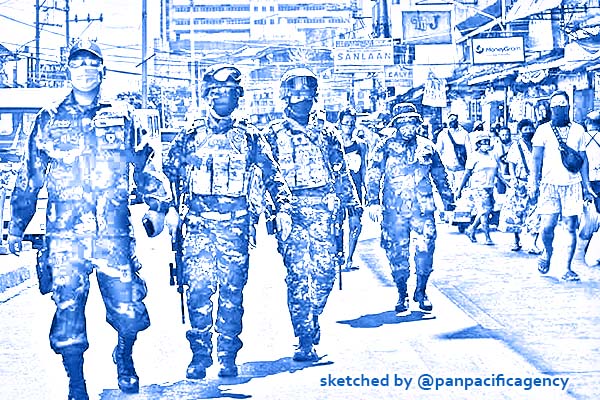Philippine capital Metro Manila mayors back shift to general community quarantine regime on June 1

Elite policemen patrol a market while people shop during a government imposed enhanced quarantine as a preventive measure against the COVID-19 novel coronavirus in Manila on April 21, 2020. AFP/Maria Tan. Sketched by the Pan Pacific Agency.
MANILA, May 27, 2020, PhilStar. The 17 mayors of the National Capital Region, members of the policy-making Metro Manila Council, will formally recommend shifting to a General Community Quarantine from June 1, The Philippine Star reported.
The STAR quotes Metro Manila Development Authority general manager Jojo Garcia as saying the mayors reached the agreement in their meeting on Tuesday night.
Although the MMC can propose the shift to a more relaxed GCQ, this is still subject to approval by the Inter-Agency Task Force for the Management of Emerging Infectious Diseases and by President Rodrigo Duterte.
The Palace said Tuesday that the IATF may decide by Wednesday on whether to move Metro Manila to GCQ.
Under GCQ, mayors will have the authority to lockdown barangays or areas with a concentration of COVID-19 cases. The smaller-scale localized lockdowns are seen as a way to curb the spread of the novel coronavirus disease without overly disrupting the economy.
A general community quarantine also has the following guidelines:
- Limited movement to services and work within Buffer Zone and Outside Buffer Zone
- Operation of government offices and industries up to maximum of 75% workforce
- Limited transporting services to support government and private operations
- Flexible learning arrangements but no face-to-face learning is allowed
- Public transport with strict safe distancing
- Inter-island (GCQ to GCQ), with safety protocols
Common protocols across community quarantine levels
According to the National Action Plan, the following safety protocols will be implemented at every level of the community quarantine:
- “No mask, no entry”
- Frequent sanitation and handwashing
- Avoid touching surfaces and face
- Stricter protocols for higher-risk occupations, industries, and spaces
People are supposed to be at least one meter apart, which could mean reconfigured work spaces in industries allowed to return to work and a prohibition of coming into to the office if showing possible COVID-19 symptoms.
Companies that are resuming operations must also have work from home as a default. Employers must provide private shuttles for their workers and all employees must undergo antibody testing and a confirmatory PCR test if necessary.